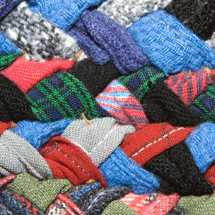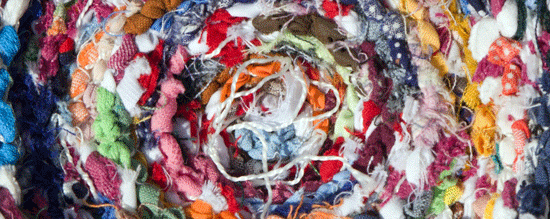 |
the rug weaver
by Bill and Brenda Evans
Read more about planned giving available to Free Will Baptists at www.fwbgifts.org.
|
THE FIRST TIME I SAW MARY, I thought she could have been Ma Joad from Steinbeck’s Grapes of Wrath. Even before she spoke, I could tell she was strong—someone with backbone. She seemed self-restrained, even melancholy, a woman accustomed to hard times, yet unafraid.
In measured words she began to tell me her business: she had money—plenty of it—but she wanted more use out of it than she was getting. It was as simple as that.
Mary has much experience in making life simple. She has been a rug weaver by avocation, one who interweaves two kinds of thread or fabric—the warp and the woof—to form rugs from rags or elaborate yarns. Her thoughts that day were as simple as rag strips attached to a loom, yet as intricate as a finished rug. She faced two financial issues: her responsibility to care for herself and her determination to benefit others serving the same Lord she served. That was all.
In some ways Mary had already done both. Catherine Mary Weidlich was one daughter among the five sons of an immigrant poultry farmer. As a child, she worked hard in her father’s three-story chicken house, mostly out of sight and out of mind. She wondered if neighbors knew she existed, for in her own family she felt invisible.
By the end of high school Mary had grown beautiful, lithe, and self-dependent, but socially overshadowed by others, especially her father and brothers. When she married Hubert and became Mary Myers in her mid-twenties, she had a long-established pattern of faithfulness to family, deference to men, public quietness, and deep empathy for others.
I saw this reflected in her eyes during our first conversation. The sixty-year-old widow was a stalwart woman who knew what it was to suffer, to struggle, to serve, to do her part. With her chin up, she looked me in the eye, said what she wanted, and wanted more than she was getting.
Mary and Hubert’s long marriage was a partnership in money and many other ways. By trade, Hubert was a linotype operator at the Parkersburg News in West Virginia. By hobby, he made furniture and cabinets. He was their main source of income.

However, twisted and misshapen legs and feet limited Hubert’s mobility, a result of polio as a child. Mary did the physically strenuous work. When the chimney soot needed sweeping, she climbed onto the roof and took care of it while Hubert scoured the bathtub. In the summer, Mary tended the garden and canned vegetables; Hubert made furniture or sharpened knives.
In other ways, Mary contributed to their income both directly and indirectly. For one thing, she wove rag rugs on two looms and demonstrated weaving at craft shows, adding her sales to their income. Indirectly, she was frugal to a fault—sometimes by choice, sometimes by Hubert’s demand. New dresses and luxury items were not approved, therefore not purchased.
Still, Mary talked (when she occasionally talked) about their exchanging “man duties” and “woman duties” because of Hubert’s physical limitations. It was something she was committed to, despite the strain it placed on her. Nor was the financial collaboration a slight load. But she adhered rigidly and irrevocably to Hubert’s weekly savings plan whether it was comfortable or not. Mary was stoic: “If we can do it, others can,” she told her friend Barbara Samms.
After Hubert was gone, talking about money to me or anyone else was not easy. She was never much of a talker anyway, because as Barbara says, “She never was allowed to, either in childhood or in marriage.” Invisible as a child, Mary was not asked her opinion. After marriage, Hubert became the spokesman and decision-maker about money and other areas of life as well.
Doing was more important than saying anyway, to Mary’s way of thinking. And Mary chose to do what she could. Throughout her married life, Mary kept a valid license but never drove. Despite his disability, driving was something Hubert could manage well enough with a few mechanical modifications. So Mary chose to stand aside, to defer to him. “If I drive, it will take away from him,” she said.
Mary’s life, like her rug weaving, has been paradoxically simple yet richly complex. She always knew her mind, but she rarely spoke it. She earned money, but another told her how to use it. Her looms were, in some ways, the frame on which she strung, not only the mottled threads of warp and woof, but her very life.
Mary engaged herself with weaving, and her kind of weaving—on a floor loom—occupied all of her body and mind. In simplest terms, weaving occurs when longitudinal warp threads interweave with latitudinal woof threads.
A loom facilitates that process by holding the warp taut so that the woof can be interwoven with them. Don’t forget, too, that weaving is a precision craft. The preparation begins with a design plan. Next, you select colors and yarn (or fabric strips if you are weaving a rag rug), thread the heddles that will guide the warp strands, load the shuttle’s bobbin with the woof yarn or strips, and if all has gone well, you can then begin to weave.
Mary refers to weaving as a full body workout—feet press the treadle and hands manipulate the shuttle, first to one side, then the other. The warp and woof: interweave, interweave, interweave, again and again and again with no rest for the weaver. Gradually, a pattern emerges and a rug takes shape, blossoming into a finished creation.
By the time I met Mary, she had already done what she could—everything was in place on the loom, so to speak. She had a simple financial design in mind: to provide for herself for the rest of her life and to give generously to those who served the Lord. The warp and woof were ready, the heddles threaded, and the shuttle poised for weaving.
When we sat down to talk about money, we talked simply about what her financial “rug” would look like when completed: This plan would
-
preserve the principle she had accumulated.
-
benefit her financially very well because of her age.
-
increase her cash flow to meet her long-term needs.
-
give lasting gifts to the Lord’s work.
-
offer good tax benefits.
Within a few weeks, Mary had pressed the treadle and moved the shuttle—the weaving had begun. She funded a Charitable Gift Annuity that would do what she wanted to do. Over the next six years, she arranged five more gift annuities that continue to sustain her financially today and will benefit the work of Free Will Baptist Bible College and International Missions for many years to come.
Reflecting back on the warp and woof of Mary’s life, I think she, like the Mary who poured rare fragrant oil over Jesus’ head and feet, has “wrought a good work.” She has done what she could, and her weavings speak as a memorial of her (Mark 14:2-9).
When I asked Mary if I could tell her story, the story of a modest rug weaver whose thrift, planning, persistence, and generosity are a model for us all, she paused for a moment. Then, with a slight smile, she nodded her consent. For Mary believes that we all ought to be doing, not just saying.
About the Writers: Bill Evans, former director of the Free Will Baptist Foundation, lives in Nashville, TN, with his wife Brenda, a retired English teacher. They are proud grandparents of six.
Two Sides of Charitable Gift Annuities
Gift annuities are like an intricately woven rug that is useful on both sides.
The Donor’s Side
-
guarantees a partially tax-free lifetime income, based on age.
-
gives an additional immediate income tax deduction.
-
provides a gift to FWB ministries.
-
requires an investment of only $5,000 or more.
The Charity’s Side
-
provides a gift to sustain ministry into the future.
-
gives encouragement that the charity’s needs will be met.
-
allows charity to make long-term budgetary planning.
Learn more about planned giving through the Free Will Baptist Foundation at www.fwbgifts.org. |

